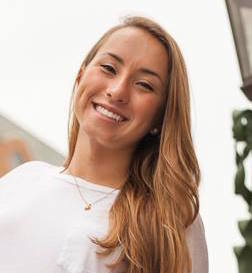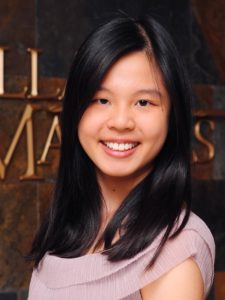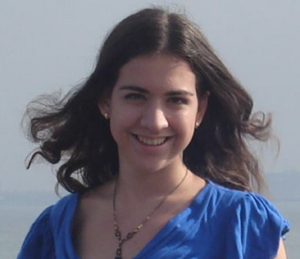Six undergraduates have been awarded research funds from the Peter B. Lewis Fund for Student Innovation in Energy and the Environment and the Dede T. Bartlett P03 Fund for Student Research in Energy and the Environment. This competitive funding supports undergraduate research on energy- and environment-related projects, particularly field work and laboratory research. The recipients will spend eight weeks this summer working under the guidance of a faculty advisor. The students’ projects, described below, are aimed at providing solutions to energy- and environment-related challenges.
Seven students were awarded funding for research in the summer of 2014.
 Anna Blyth ‘18
Anna Blyth ‘18
(Faculty Advisor – Claire White, Department of Civil and Environmental Engineering and the Andlinger Center for Energy and the Environment)
Title: Predicting Long-term Durability of Sustainable Alkali-Activated Cements Using the Beam-bending Technique
Abstract: The purpose of this internship is to produce additional data about alkali-activated concrete (AAC) permeability using the beam-bending technique. For the AAC binders being analyzed in Professor Claire White’s group, permeability may be an important factor in dictating which mixes show resistance to various forms of chemical degradation during accelerated testing (sulfate attack, carbonation). We hope to produce data which indicates that AAC will be a sustainable material to use in future construction, as well as environmentally friendly. This is important because there is currently little data on the long-term durability of AAC that would allow for its implementation. This internship seeks to analyze concrete binders using a higher load cell (500N instead of 100N used for hydroxide-activated slag) to induce a sufficient pressure difference in the pore solution so that hydrodynamic relaxation is measurable using the beam-bending technique.
 Isabella Douglas ‘17
Isabella Douglas ‘17
(Faculty Advisor – Forrest Meggers, School of Architecture and the Andlinger Center for Energy and the Environment)
Title: Cooling and Heating for Architecturally Optimized Systems (CHAOS) Lab Research Intern
Abstract: The CHAOS Lab researches the effective operation of integrated building systems through the development of better methods and novel technologies for improved building performance. My internship would be a combination of working on various ongoing and developing projects to give me hands-on lab experience. My personal desire for this summer is to be able to work with materials and physical prototypes to develop a more innate understanding of the theoretical material being researched by this lab group. This internship will serve to contribute to the progress and evaluation of the prototypes in development as part of the Beyond Shading project. Additionally, the research will expand into the area of ventilation, and the development of an innovative system evaluation chamber as part of the new Andlinger Center for Energy and the Environment building space. My hope is that I will get exposure to many aspects of the CHAOS lab while gaining a detailed understanding of some aspects, and a broad perspective of the overall objectives and projects of the group.
 Samantha Ip ‘18
Samantha Ip ‘18
(Faculty Advisor – Jose Avalos, Department of Chemical and Biological Engineering and the Andlinger Center for Energy and the Environment)
Title: Engineering the Mevalonate Metabolic Pathway in Yeast
Abstract: The primary purpose of this internship will be to work on a research project on engineering the metabolic pathway for mevalonate in yeast. Mevalonate is a highly desirable product, as it can be used as a building block for synthesizing biofuels, industrial chemicals, plastics, and specialty chemicals such as drugs and fragrances. Although the mevalonate pathway is naturally present in most cells (all eukaryotic and some bacterial cells), the purpose of this project will be to alter the mevalonate pathway in yeast in order to further enhance its efficiency. If successful, our mevalonate-overproducing strain will establish a yeast platform for the sustainable production of the multiple fuels and chemicals that can be synthesized from mevalonate.
 Anastasia Ivanushkina ‘17
Anastasia Ivanushkina ‘17
(Faculty Advisor – Lynn Loo, Department of Chemical and Biological Engineering)
Title: Charge Transport in Amorphous Polymer Semiconductors Produced by Flash Nanoprecipitation
Abstract: This project utilizes flash nanoprecipitation, a quick process that has been used to synthesize solid particles at small timescales, thus precluding crystallization, in order to create amorphous polymer semiconducting layers without grains or boundaries (which normally form during crystallization). These should have unrestricted pi orbital overlap, a state which has never been achieved before and has the potential to have very useful applications in electronics. The aim will be to synthesize this material using a flash nanoprecipitation process, and observe its physical and electrical properties. One of the ways we will test this is by incorporating it into a variety of electrical devices to gather information on its performance and potential useful properties.
 Hanley Ong ‘16
Hanley Ong ‘16
(Faculty Advisor – Paul Chirik, Department of Chemistry)
Title: Sustainable Catalysis for a Resource Limited World
Abstract: Through this internship, I will focus on developing base metal catalysts to substitute for precious metal catalysts with larger environmental footprints. By optimizing ligand design (the groups attached to the metal atom in the catalyst complex), it is possible to make better catalysts. Consequently, I will be testing different ligands, making modifications in order to optimize catalytic activity of the base metal complexes being investigated. By the end of this internship, I will have gained extensive experience in organometallic catalysis and hopefully identified several important new base catalysts, placing me in an ideal position to conduct more exciting chemistry in my senior year.
 Michael Wang ‘16
Michael Wang ‘16
(Faculty Advisor – Daniel Steingart, Department of Mechanical and Aerospace Engineering and the Andlinger Center for Energy and the Environment)
Title: An in situ Study of Zinc Electroplating in Alkaline Batteries using Ultrasonic Characterization
Abstract: This project will involve replicating the zinc electroplating process in a controlled setting using the same materials found in a standard zinc alkaline battery. It is known that different plating regimes lead to corresponding zinc morphologies and so multiple plating regimes will be studied. During the electroplating process, acoustic signals will be emitted through the electrode and received by a receiver on the other side of the material. Based on the perceived speed of the material, density shifts corresponding to zinc growth will be observed in-situ. The corresponding density shifts will then be matched and compared to known models of zinc growth and phase transformations. From the obtained data, a possible model or mechanism of the zinc growth may be created. This will also be confirmed through the use of standard ex-situ characterization including optical and electron microscopy.